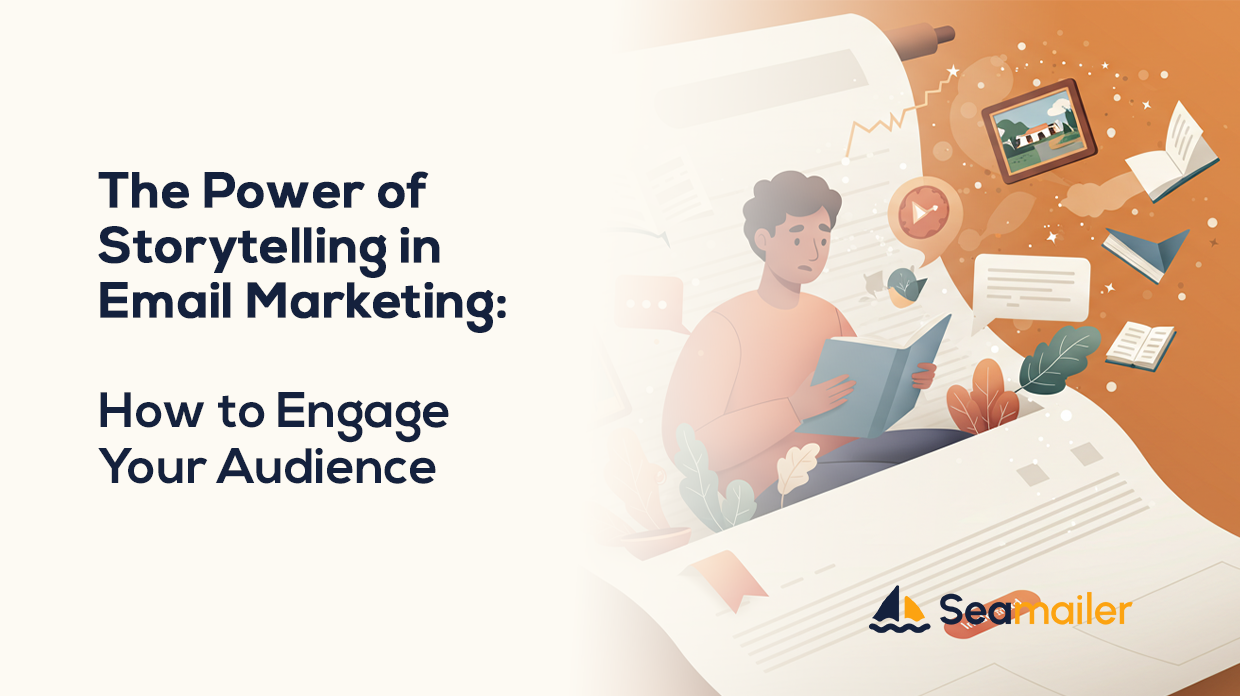The Power of Storytelling in Email Marketing: How to Engage Your Audience

Storytelling is a powerful tool in email marketing that can help you connect with your audience, build trust, and drive conversions. By sharing stories that resonate with your subscribers, you can create an emotional connection that goes beyond mere sales pitches.
Continue reading to discover:
- Why Storytelling Matters
- The Psychology Behind Storytelling in Marketing
- Why storytelling works in Email Marketing
- Types of Stories to tell in Email Marketing
- How Storytelling Enhances Email Engagement
- Elements of a Great Story in Email Campaigns
- Storytelling Email Formats That Work
- How to Write Engaging Stories in Your Emails
- Common Mistakes to Avoid
- Using seamailer to Craft Story-Driven Campaigns
Why Storytelling Matters
Storytelling isn’t just a buzzword it’s a proven way to break through inbox fatigue and create emotional connections that drive conversion.
The Psychology Behind Storytelling in Marketing
Humans are hardwired for stories. It’s how we make sense of the world, remember information, and connect emotionally. When you tell a story in an email You activate multiple areas of the brain, making your message more memorable. You trigger emotional resonance, which increases trust and engagement. You guide the reader on a journey moving them from a problem to a solution (your offer). Psychologists call this the “narrative transportation effect” when people become immersed in a story, they are more open to new ideas and more likely to take action.
Why Storytelling Works in Email Marketing
Emotional Connection: Stories have the power to evoke emotions, which can lead to a deeper connection with your audience.
Memorability: Stories are more memorable than facts and figures, making them more likely to stick in your subscribers' minds.
Authenticity: Stories can convey authenticity and vulnerability, which can help build trust with your audience.
Types of Stories to Tell in Email Marketing
Brand Stories: Share the story of how your brand came to be, your values, and your mission.
Customer Stories: Share stories of how your customers have benefited from your product or service.
Product Stories: Share the story behind your product or service, including its features and benefits.
How Storytelling Enhances Email Engagement
Story-driven emails outperform traditional promotional messages because they:
Feel personal and authentic.
Build curiosity and anticipation.
Make your brand relatable and human.
Increase open rates and click-through rates.
Reduce unsubscribes and improve loyalty.
In a world of automation and AI, storytelling adds the human touch that sets you apart.
Elements of a Great Story in Email Campaigns
Every great email story includes: A relatable protagonist: Often your customer, you, or someone in your niche. A challenge or conflict: The problem that resonates with your audience. A turning point: The discovery of a solution ideally your product/service. A resolution: How life improved, leading into your CTA.
For example:
Before: “I used to waste 5 hours a week writing emails…”
Conflict: “My open rates were embarrassing below 10%.”
Turning Point: “Then I discovered seamailer
After: “Now my list is engaged, and my revenue is up 40%.”
Storytelling Email Formats That Work
Here are formats where storytelling shines:
Founder’s Story
Great for welcome emails or About Us campaigns. Share your mission and journey to connect emotionally.
Customer Testimonials as Stories
Turn user reviews into mini case studies with a beginning, middle, and end.
Behind the-Scenes Narratives
Give a sneak peek of product creation, team stories, or how a feature was born.
Problem-Solution Sequences
Start with a pain point your reader feels, and show how your solution helped someone overcome it.
Educational with a Story Arc
Use storytelling to explain a concept or teach something valuable in a memorable way.
How to Write Engaging Stories in Your Emails
Know Your Audience
Identify what keeps them up at night, what goals they have, and what language they use.
Choose a Relatable Character
Make the reader see themselves in your story either by using a persona like them or by reflecting their situation.
Create Conflict
What’s the problem? What frustration or desire can your reader relate to?
Present Your Product as the Hero
Don’t make the product the main character. It’s the guide that helps the protagonist succeed.
Add Emotional Hooks
Use emotion-driven words and metaphors. Use real dialogue or feelings when possible.
End with a Purpose
Wrap it up with a CTA that flows naturally from the story. (“Want the same results? Try today.”)
Common Mistakes to Avoid
Being too vague: Stories need detail. Paint the picture.
Not tying it to your offer: Every story should drive to a purpose.
Overloading on facts: Stats are useful but need a story to stick.
Making it all about you: Your reader should always be the hero.
Using Seamailer to Craft Story-Driven Campaigns
Seamailer is built to help you connect not just broadcast. Here’s how:
Drag-and-drop editors to structure narrative flows.
Segmentation tools so you can tailor stories to different audiences.
A/B testing to see which storytelling format works best.
Automated sequences that let you build multi-part stories that unfold over time.
And with built-in analytics, you’ll see how your stories are performing from open rates to conversions.
Conclusion
Storytelling is a powerful tool in email marketing that can help you connect with your audience, build trust, and drive conversions. By sharing stories that resonate with your subscribers, you can create an emotional connection that goes beyond mere sales pitches. By following the tips outlined above, you can craft compelling stories that engage your audience and drive results for your business.
storytelling in email marketing is the difference between a forgettable campaign and one that drives real connection and real results.

